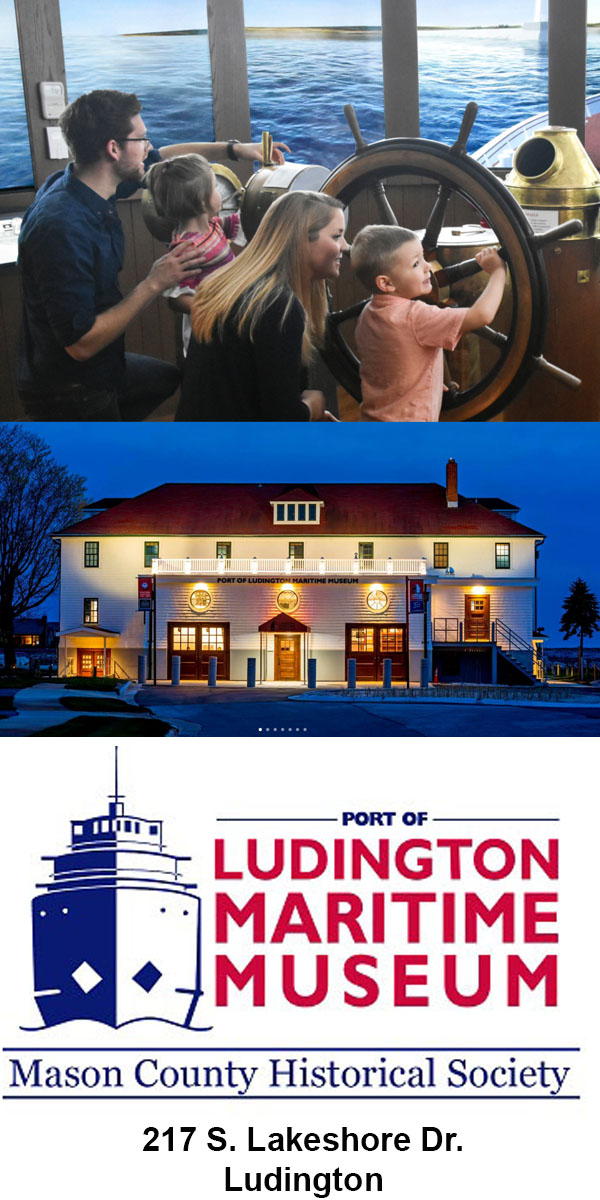ON-BOARD-THE-SS-BADGER – The carferries have a tradition in Ludington dating back to 1897. At one time Ludington alone had seven carferries operating out of its port, transporting railroad cars across Lake Michigan to the Wisconsin ports of Milwaukee, Manitowoc and Keewaunee. Other Michigan ports such as Frankfort and Muskegon also had carferries. This meant dozens of captains operating the steam ships.
Today, Dean Hobbs and Jeff Curtis are the only two steam carferry captains working full time on the Great Lakes. They are the captains of the 410-foot S.S. Badger, the last remaining operational steamship on Lake Michigan.
Hobbs started working for Lake Michigan Carferry, the Badger’s owner, in 1995. This is Curtis’ first season on the Badger.
“What the crew does here on the Badger is pretty remarkable,” Hobbs says.
“The tradition of operating this ship is handed down captain to captain and crew to crew,” Hobbs said. “There is a lot of pride on board this ship.”
One of the major duties of the Badger’s captain is to back the ship into dock from the aft pilot house. This is done after the Badger enters port and the anchor is dropped.
Capt. Jeff Curtis, wearing a traditional white captain’s uniform and hat, maneuvers the ship using the various controls. Every once in a while he will move a lever that sends off a series of rings down to the engine room, communicating with personnel down there the speed of the ship’s engines.
The procedure takes about 10 or 15 minutes from the time the anchor is dropped. The aft pilot house, located on the main passenger deck has windows on port and starboard sides so passengers can look in. This is serious business, though, and the captain doesn’t let the on-lookers distract him from his duties. However, when he finishes docking the ship, on this particular day, he glancesto his right and notices a little girl looking at him, waving with a big smile.
“That is the best part of this job,” Curtis says, now grinning himself. As he walks back onto the passenger deck a woman stopped and asked if she could get her picture taken with him. The captain obliges.
“I love this job,” he tells me. “In the rest of the maritime industry here on the Great Lakes captains and pilots are doing amazing ship handling but no one sees it. Here, on the Badger, I get the thrill of having an audience for my work.
“Of course, the downside is if I screw up I will most likely end up on Youtube.”
Curtis started working for Lake Michigan Carferry this season replacing Capt. Kevin Fitch who left for another job. Curtis and Senior Captain Dean Hobbs are the two regular captains on board the historic vessel.
Hobbs said he will never forget his first experience operating the Badger. He was riding with Capt. Bruce Masse on a goodwill tour to Chicago’s Navy Pier.
“Bruce had never taken a ship into Navy Pier before,” Hobbs says. “He had taken ships into the Wisconsin ports of Kewaunee, Milwaukee and Manitowoc but Chicago scared the heck out of him.
“So, we took the Badger into Navy Pier as you would take a typical steam ship into any port. You get about 2 miles from the breakwater you slow down to half speed. When you are a mile out you slow down to 1 or 3 knots per hour depending on the wind. Well, that was not Bruce’s comfort level. It was too slow and methodical.
“I took the Badger out of Chicago and turned it around and we left, again, typical steamboat fashion. When we got back to Ludington, Bruce was back in his comfort zone. He said, ‘now I will show you how we do it C&O style,’ referring to the C&O Railroad that used to own the Ludington carferries.
“So we got two miles from Ludington breakwater and he didn’t slow the ship down. I suggested we slow down, but we didn’t. We got one mile from the breakwater and he put the engines on standby. At half mile from the breakwater he finally put the engines at half. We went past the breakwater doing 13.5 knots, 10.5 knots faster than going into Chicago! Then he checked from half to slow somewhere near the inner green light. As we went by the Coast Guard station we were doing 10 knots. We got to the corner and he gave the wheelsman the order to turn hard right and starboard at half stern. The boat started spinning. He pushed the button and the anchor went down and he said ‘we have to go to the aft pilot house.’
“It seemed like a pretty out of control experience from that pilot house. My first thought was ‘I can’t do this. This is insanity.’ In fact, I called my old job and asked if I could come back. Bruce told me to give it some time. Over the next couple of weeks I started going back and forth to Manitowoc and it came to be more reasonable to me. Now it’s sort of second nature.”
Prior to working for the Badger, Curtis worked for 14 years as a federal pilot for the Western Great Lakes Pilots Association. The Badger is certainly a different experience.
“We don’t have a bow thruster,” Hobbs says. “We use an anchor and the engines and a single rudder, pretty much the same way it was done over 100 years ago. The tradition of operating this ship is handed down from captain to captain and crew to crew. There is a level of pride that is handed down. This is a legacy.”
“The Badger was built in 1952 and put into service in 1953,” Curtis explains. “Not much about this ship has changed since then. This is a tall ship so the wind affects it a lot. Because there isn’t a bow thruster and the one rudder is set between the two propellers we need to maintain more speed to maintain control than would be normal on other ships.”
So what is a typical day like for the captain of the S.S. Badger?
“It goes like this,” Curtis explains. “I relieve Capt. Hobbs when the ship arrives in Ludington around 7 p.m. I check the computer for company email and also for the weather forecast. I then check the galley for cookies.
“We depart Ludington at 8:30 p.m. (this interview took place when the Badger was operating dual sailings, which ended the beginning of this week). In the evening I try to get as much sleep as possible. The mate will give me a call 30 minutes before the Manitowoc breakwater. I come to the wheelhouse and get the rundown of the weather and boat traffic for docking. I dock the ship between 12:30 and 12:40 a.m. Eastern Time. I get a bite to eat and check for more cookies. I then check the computer for emails and weather and then wait for departure.
“We depart Manitowoc at 2 a.m. Eastern Time and again after we leave port I try to get as much sleep as possible. Around 5:30 a.m. the mate will call me, which is 30 minutes from Ludington. It’s then the same routine going into Ludington as going into Manitowoc. We dock around 6 a.m.
“If I feel I have gotten enough sleep I will take a run otherwise I will nap until around 8 a.m. I then have some breakfast, check for cookies, check the computer for emails and weather. We depart Ludington at 9 a.m.
“In the morning I like to try to walk through the vessel, talk to passengers, answer questions and look for cookies. Around 11 a.m. I get lunch and take a short nap. When we arrive in Manitowoc in the afternoon it’s nice to take a bike ride. I also like to talk to people on the dock. They always have interesting questions.
“We depart Manitowoc around 3 p.m. Eastern Time and it’s back to Ludington. I try to walk through the vessel again and talk to passengers. At 5 p.m. it’s supper time after which I get a short nap until the mate wakes me up 30 minutes from Ludington. I dock the ship around 7 p.m. and it starts all over again.
“At the end of the second day Capt. Hobbs is a welcome sign to relieve me.”
Both captains respect the water and enjoy the uniqueness of the Badger.
“I like working on ships as the water is an amazingly beautiful and ominous entity,” Curtis says. “You need to pay attention and respect the power the lake has.
“The Badger is a unique job as unlike other ships here on the Great Lake the cargo (people) can tell you what they like or don’t like. Never before in the industry have I been applauded for doing a good job. As well, I often get people who want to have a picture with the captain or want my autograph. This is why I wear the full uniform. I think it’s important. Most of the passengers have very little experience with ships or the water. They may be nervous or apprehensive and when they see the uniform, that can help them be more comfortable or enjoy the experience more.”



































































.png)
